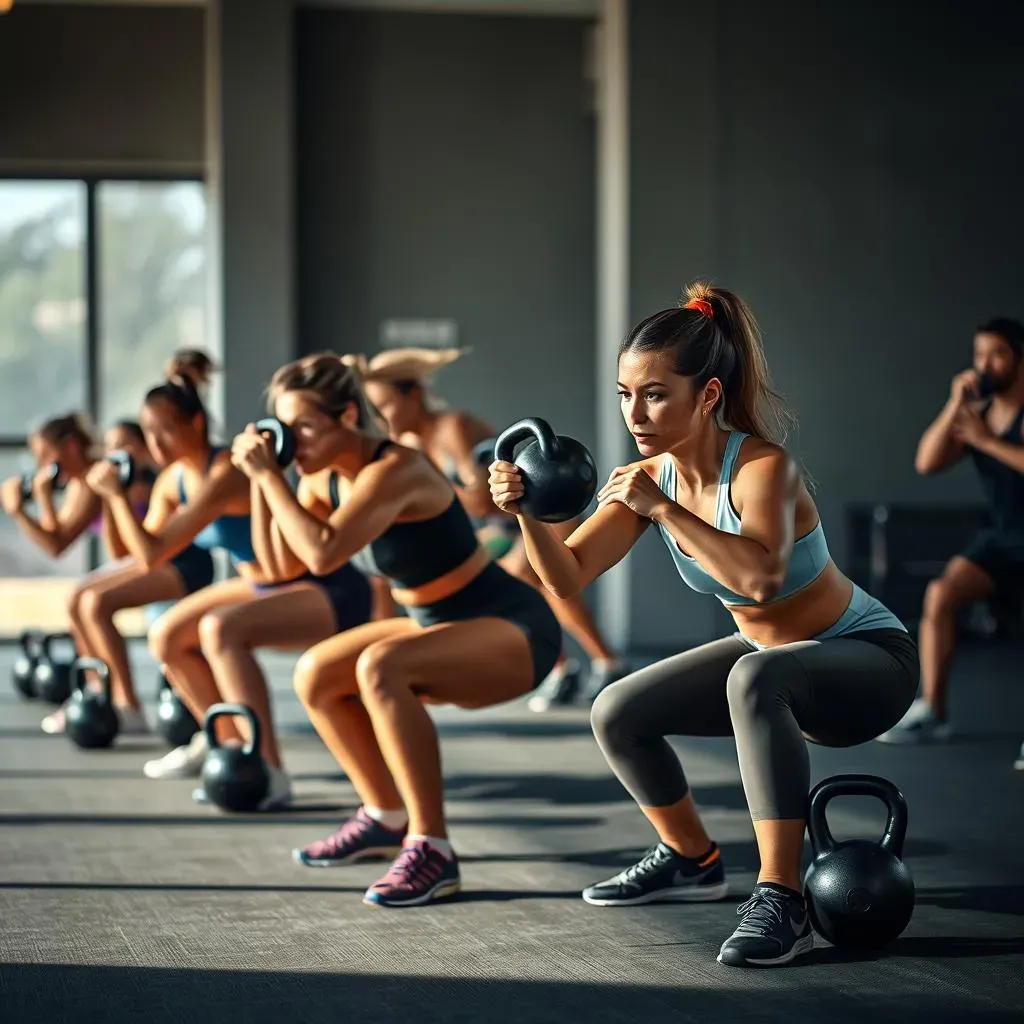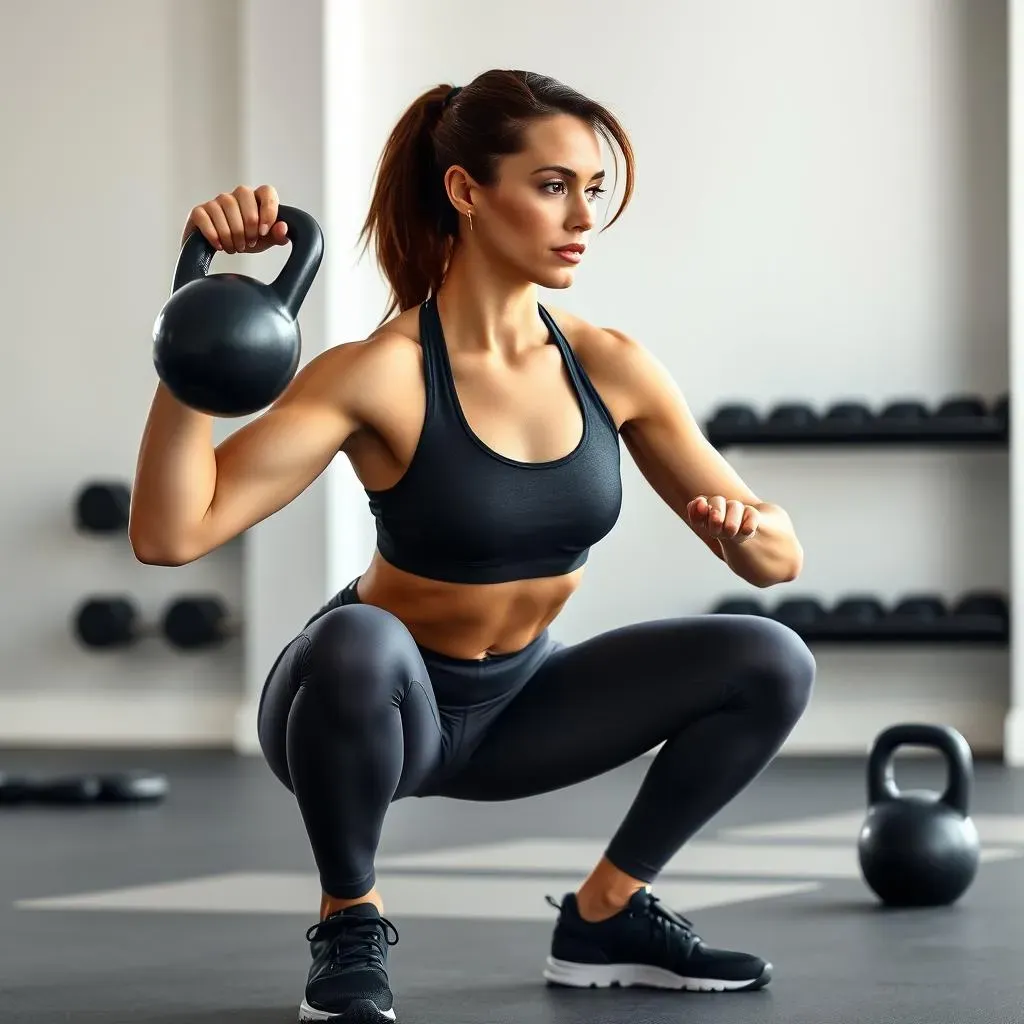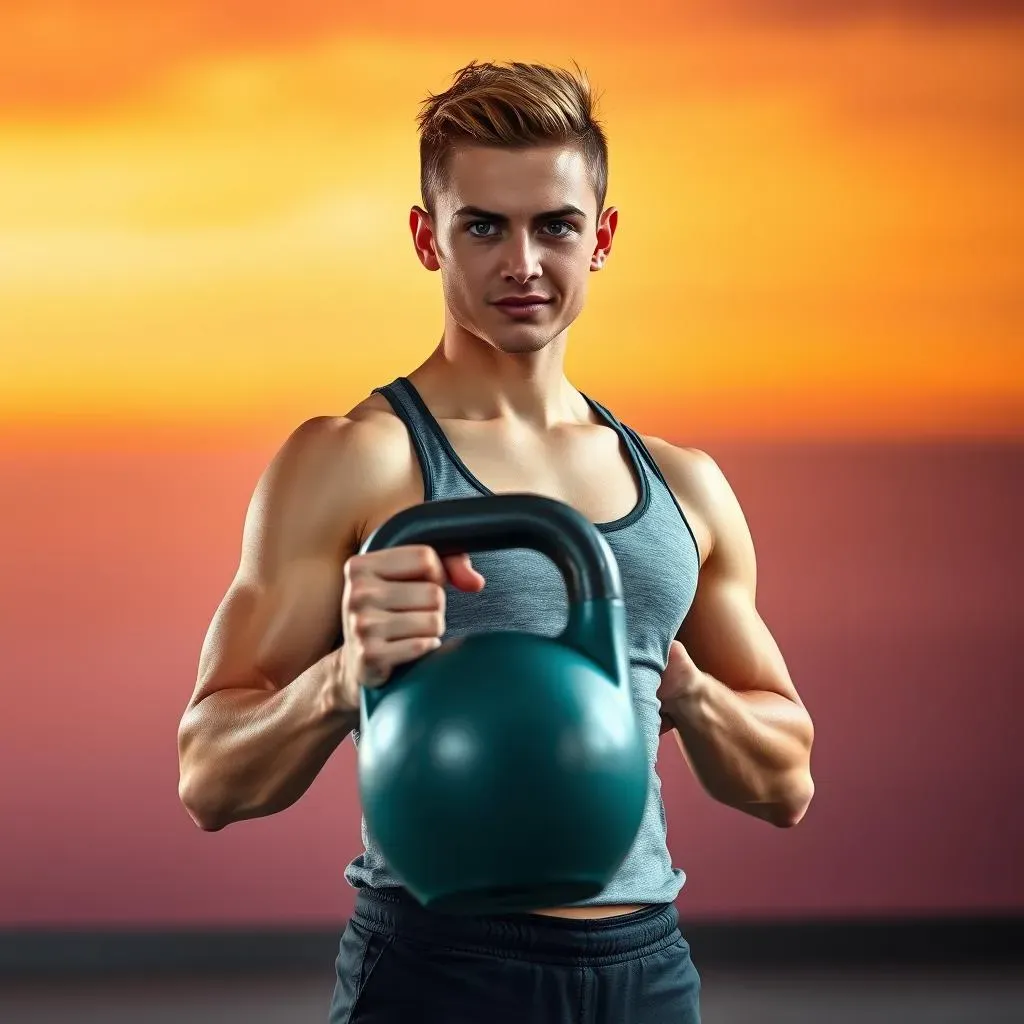Table of Contents
Ready to sculpt stronger legs and a tighter butt without endless hours at the gym? A kettlebell leg workout for beginners is your secret weapon! Kettlebells offer a unique blend of strength and cardio, making them perfect for building lean muscle, burning fat, and improving overall fitness. Forget complicated machines and intimidating weight racks. With just one kettlebell, you can unlock a full-body transformation, starting with your legs.
Essential Kettlebell Leg Exercises for Beginners

Essential Kettlebell Leg Exercises for Beginners
Goblet Squat: Your Foundation
The Goblet Squat is the king (or queen!) of essential kettlebell leg exercises for beginners. Why? It teaches proper squat form, engages your core, and builds serious quad strength. Holding the kettlebell close to your chest acts as a counterbalance, helping you sit back into a deep, controlled squat. Think of it as a guided squat, setting you up for success with heavier lifts down the road.
To perform a Goblet Squat, stand with your feet slightly wider than shoulder-width apart, toes pointed slightly outward. Hold the kettlebell by the horns (the handle) close to your chest. Keeping your chest up and back straight, lower yourself down as if sitting into a chair, going as deep as you comfortably can while maintaining good form. Push through your heels to return to the starting position. Aim for 3 sets of 8-12 reps.
Kettlebell Swing: Power Up Your Posterior Chain
No essential kettlebell leg exercises for beginners list is complete without the Kettlebell Swing. This dynamic movement is a powerhouse for your glutes, hamstrings, and core. It's also a fantastic way to improve your cardiovascular fitness and burn calories. The swing teaches you to hinge at the hips, generating power from your posterior chain – crucial for athletic movements and everyday activities.
Start with the kettlebell a few inches in front of you. Hinge at your hips, keeping your back straight, and grab the kettlebell with both hands. Hike the kettlebell back between your legs, then explosively drive your hips forward, swinging the kettlebell up to chest height. Let the kettlebell swing back down, controlling the movement with your hamstrings and glutes. Repeat for 3 sets of 15-20 reps, focusing on generating power from your hips, not your arms.
Exercise | Sets | Reps | Focus |
|---|---|---|---|
Goblet Squat | 3 | 8-12 | Quad Strength & Squat Form |
Kettlebell Swing | 3 | 15-20 | Glutes, Hamstrings & Power |
Beginner Kettlebell Leg Workout: Your First Steps

Beginner Kettlebell Leg Workout: Your First Steps
Alright, so you're ready to take your first steps with a beginner kettlebell leg workout? Awesome! The key here is to start slow, focus on form, and gradually increase the intensity. Don't jump into advanced exercises right away. Master the basics, and your body will thank you later. This isn't a race; it's about building a solid foundation for long-term strength and fitness. Think of this workout as a way to introduce your muscles to the movements and get comfortable with the kettlebell.
We're going to focus on a few key exercises that are perfect for beginners. These movements will target all the major muscle groups in your legs, including your quads, hamstrings, and glutes. Remember, consistency is key. Aim to do this workout 2-3 times per week, with a day of rest in between. As you get stronger, you can increase the weight of the kettlebell or add more sets and reps. But for now, let's focus on nailing the form and building a good habit.
Progressing Your Kettlebell Leg Workout: From Beginner to Beyond

Progressing Your Kettlebell Leg Workout: From Beginner to Beyond
Increase the Weight: The Obvious Choice
So, you've mastered the basic kettlebell leg workout, and you're feeling stronger? Awesome! The most straightforward way to progress your kettlebell leg workout: from beginner to beyond is to simply increase the weight. This forces your muscles to work harder, leading to continued strength gains and muscle growth. But before you grab the heaviest kettlebell in the gym, let's talk about proper form. It's crucial to maintain good technique, even as you increase the weight. If your form starts to break down, it's a sign that you're not ready to move up just yet. Focus on controlled movements and engaging your core to protect your back.
How do you know when it's time to increase the weight? A good rule of thumb is that if you can comfortably perform all the sets and reps with good form, it's time to challenge yourself with a heavier kettlebell. Start by increasing the weight by a small increment, such as 2-4kg, and see how it feels. If it's too easy, you can always increase it again. The goal is to find a weight that challenges you without compromising your form.
Introduce Advanced Exercises: Level Up Your Movements
Once you've built a solid foundation with the basic exercises, it's time to introduce some more advanced movements into your kettlebell leg workout: from beginner to beyond. This will not only challenge your muscles in new ways but also keep your workouts interesting and engaging. Think about adding exercises like single-leg deadlifts, pistol squats (if you're feeling ambitious!), and various lunge variations. These exercises require more balance, coordination, and strength, so start slowly and gradually increase the difficulty as you get stronger.
For example, instead of just doing regular lunges, try adding a twist to challenge your core. Or, instead of doing standard deadlifts, try single-leg deadlifts to improve your balance and stability. The key is to experiment with different variations and find what works best for you. Don't be afraid to try new things, but always prioritize proper form over ego lifting.
Manipulate Reps, Sets, and Rest: Fine-Tune Your Training
Another way to progress your kettlebell leg workout: from beginner to beyond is to manipulate the reps, sets, and rest periods. This allows you to target different aspects of your fitness, such as strength, endurance, and muscle growth. For example, if you're aiming for strength gains, you might focus on lower reps (5-8) with heavier weight and longer rest periods (2-3 minutes). On the other hand, if you're aiming for endurance, you might focus on higher reps (15-20) with lighter weight and shorter rest periods (30-60 seconds).
You can also experiment with different set structures, such as supersets (performing two exercises back-to-back) or circuits (performing a series of exercises with minimal rest). These techniques can help you increase the intensity of your workouts and burn more calories. Just remember to listen to your body and adjust the reps, sets, and rest periods as needed. There's no one-size-fits-all approach, so find what works best for you and your goals.
Progression Method | Description | Benefits |
|---|---|---|
Increase Weight | Gradually lift heavier kettlebells. | Builds strength and muscle mass. |
Advanced Exercises | Incorporate single-leg and complex movements. | Improves balance, coordination, and overall strength. |
Rep/Set/Rest Manipulation | Adjust reps, sets, and rest for different goals. | Targets strength, endurance, and muscle growth. |
Kettlebell Leg Workout for Beginners: FAQs and Expert Tips

Kettlebell Leg Workout for Beginners: FAQs and Expert Tips
Are Kettlebells Effective for Building Glutes?
This is probably the number one question I get about kettlebell leg workouts for beginners. And the answer is a resounding YES! Kettlebells are fantastic for glute development. The swing, in particular, is a glute-activating machine. But it's not just the swing. Squats, lunges, and deadlifts, when performed with a kettlebell, force you to engage your glutes for stability and power. Plus, the unique offset loading of kettlebells (especially when using a single kettlebell) challenges your glutes in a way that traditional barbell exercises sometimes miss.
Think about it: every time you perform a single-leg deadlift or a suitcase carry, your glutes are working overtime to keep you balanced and upright. This constant engagement leads to serious glute growth and definition. So, if you're looking to build a stronger, more sculpted butt, don't underestimate the power of kettlebells! Just remember to focus on proper form and progressive overload to see the best results.
Can I Build Calves with Kettlebells?
While kettlebells aren't the *primary* tool for calf-specific training, they can definitely contribute to calf development as part of a well-rounded kettlebell leg workout for beginners. Exercises like kettlebell swings and goblet squats engage the calves to some extent, especially during the explosive portions of the movement. However, if you're serious about building bigger calves, you'll want to incorporate some dedicated calf exercises into your routine. Think about adding kettlebell-loaded calf raises, either standing or seated, to really target those muscles. You can hold a kettlebell in one hand for added resistance or place it on your thighs while seated.
Also, consider incorporating single-leg variations of kettlebell exercises. For example, performing a single-leg deadlift with a kettlebell forces your calf muscles to work harder to stabilize your ankle and maintain balance. This added challenge can lead to increased calf activation and growth. Remember, consistency is key. Perform calf-focused exercises 2-3 times per week, and gradually increase the weight or reps as you get stronger.
Expert Tips for Kettlebell Leg Day
Alright, let's wrap things up with some expert tips to maximize your kettlebell leg workout for beginners. First, always prioritize form over weight. It's better to use a lighter kettlebell and perform the exercises correctly than to use a heavier kettlebell and risk injury. Second, don't neglect your warm-up. A proper warm-up will help prepare your muscles for the workout and reduce your risk of injury. Think about including dynamic stretches like leg swings, hip circles, and torso twists.
Third, listen to your body. If you're feeling pain, stop the exercise and rest. There's no shame in taking a break or modifying the exercise to make it more comfortable. Fourth, don't be afraid to experiment with different exercises and variations. Kettlebells are incredibly versatile, so find what works best for you and your goals. And finally, be patient. Building strength and muscle takes time and consistency. Don't get discouraged if you don't see results overnight. Just keep showing up, putting in the work, and you'll eventually reach your goals.
Tip | Description |
|---|---|
Prioritize Form | Focus on proper technique over heavy weight. |
Warm-Up Properly | Prepare your muscles with dynamic stretches. |
Listen to Your Body | Rest when needed and modify exercises as necessary. |
Experiment | Find exercises and variations that work for you. |
Be Patient | Consistency is key to long-term results. |
Conclusion: Your Kettlebell Leg Journey Starts Now
You've now got the tools and knowledge to conquer a kettlebell leg workout for beginners. Remember, consistency is key. Start slow, focus on proper form, and gradually increase the weight or reps as you get stronger. Kettlebells are incredibly versatile, offering a fun and effective way to build lower body strength, improve your fitness, and achieve your goals. Don't be afraid to experiment with different exercises and workout structures to find what works best for you. Now go out there and make those legs burn!